Disabled community let down by authorities’ lack of will, poor coordination
by Erna Mahyuni on 28 Apr, 2010
in Cheras, Features, Other Areas.Speaking to people with disabilities advocate Peter Tan, Komunitikini got the rundown on the current situation and challenges faced by the disabled community in Malaysia.
Tan, a trained peer counselor, said that despite existing legislation for building proper facilities for the disabled there was still a lack of accessible facilities for the community.
“My trips out are still limited to places that have some basic accessible facilities such as ramps, (disabled) toilets and elevators.” The lack of these facilities hamper Tan and others like him who struggle with an environment that does not take into account their challenges in doing something as fundamental as moving around.
“There is better awareness of (our) issues but the situation is not improving, ” said Tan. He attributed it to a general “lack of will” on the part of the authorities whether they were at federal, state or local levels to take the necessary steps to improve things.
Citing the existence of the Uniform Building By-Law 34A, which had been in existence since the mid-90s, he said that the law required new buildings to provide access for the disabled. Builds already completed or under construction when the by-law was gazetted were given three years to comply with the applicable standards for construction: Malaysian standards MS 1183 and 1184.
“15 years on,” he noted, “Many buildings still do not comply with those requirements.”
Another problem, Tan noted is the lack of enforcement of said standards.
“Compliance with the UBBL 34A is the responsibility of the local governments, but they do not have qualified personnel to ensure compliance.”
Of the newer buildings that do include disabled facilities, Tan said that often the facilities were not built according to standards. For instance, disabled toilet stalls that were too small, doors that open inside, ramps that were too steep were common problems coupled with street environments that Tan called “totally hostile to disabled people.”
He noted The Gardens at Mid Valley City as an example of near perfect accessible facilities. “If not for the ramp leading to the lift lobby at P2.” Tan said the ramp had a flaw that could cause a wheelchair to tip backwards.
What irks Tan is that though there may be accessible buildings, getting to them is difficult. “What we have here is an island of accessible facilities in an ocean of barriers, ” he said. He called it a circle of mobility that was, for most disabled people, broken in many parts.
Asked about what could be done about the situation, Tan said one step would be for the disabled to unite and find a common platform.
“Many are interested in charity at the expense of advocating for the rights of disabled people.
“First, we need to come together and work together for the common good. Our voices cannot be heard if we don’t speak in a united voice.
“There are too many people trying to do the same thing,” he said.
Tag: Uniform Building By-Law 34A
MPAJ Launches Guidelines For Accessible Facilities
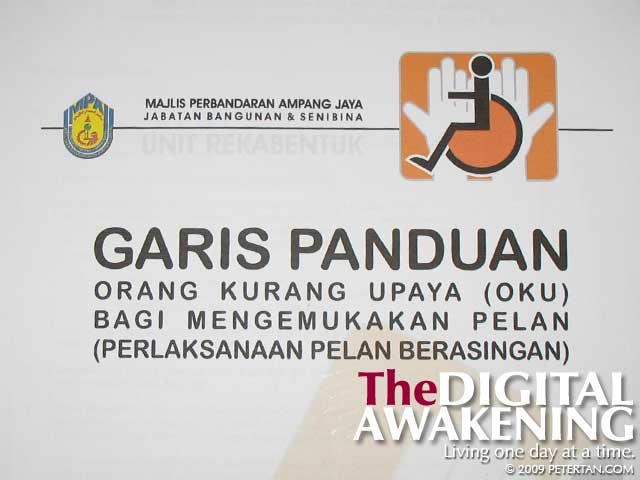
In conjunction with its Hari Kesedaran dan Simulasi OKU last Thursday, Majlis Perbandaran Ampang Jaya also launched the Garis Panduan Orang Kurang Upaya (OKU) Bagi Mengemukakan Pelan (Perlaksanaan Pelan Berasingan). Translated it means Guidelines for Plan Submission for Disabled People (Implementation of Separate Plan). In my opinion, it should have instead read as: Garis Panduan Bagi Mengemukakan Kemudahan OKU or Guidelines on Facilities for Disabled People.
That aside, I am glad that disabled people have come to this stage in our advocacy for accessible facilities in the Ampang Jaya municipality. This is a very positive step for many of us who have been looking forward to such facilities. The guidelines have a checklist and specifications on ramps, pathways and corridors, stairs, doors and entrances, elevators, toilets, lobby and car parking spaces.
The most important aspect of this implementation is the requirement for the submission of a separate plan for accessible facilities. This is to ensure that the plans comply with Malaysian Standard MS 1184 before they are approved. This guideline left out Malaysian Standard MS 1183: Part 8: 1990: Specifications for Fire Precautions in the Design and Construction of Buildings Part 8: Code of Practice for Means of Escape for Disabled People which I feel should have been included.
Teratai ADUN Jenice Lee, MPAJ Council Member Chan Su Sann and MPAJ Jabatan Belia dan Masyarakat Officer Noryani Roslan have been instrumental in pushing this matter up to this stage. Nevertheless, I will raise a few points regarding the guideline as I feel that the requirements are not comprehensive or specific enough. All said, I am happy to see progress in this matter although the moving is slow from the first time I lodged a complaint with MPAJ in 2006.
Disability Awareness Training At MPAJ
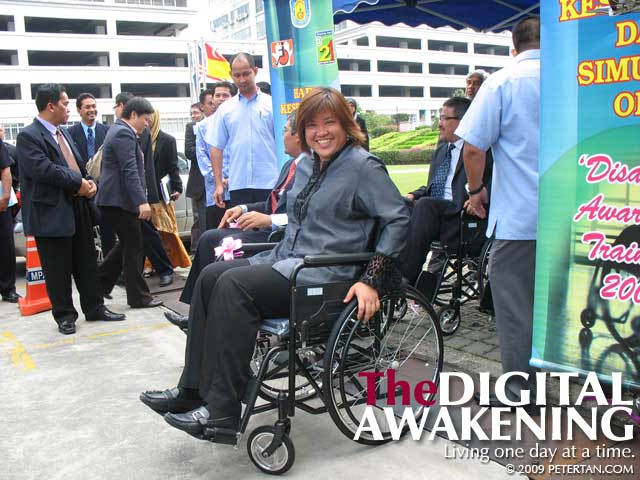
MPAJ Council Member Chan Su Sann and MPAJ President Dato’ Mohammad Bin Yacob beside her on wheelchairs before the simulation exercise.
Many government buildings in Malaysia are still inaccessible to disabled people. This is a crying shame as these buildings should be the first to comply with accessibility standards namely Malaysian Standard MS 1184: Code of Practice on Access for Disabled Persons to Public Buildings. The government should lead by example. If not how else are they going to enforce By-Law 34A of the Uniform Building By-Law (UBBL 34A) that requires all public buildings provide access to disabled people? It is ironic for the municipal government to penalize developers and building owners when their own premises are blatant examples of inaccessibility.
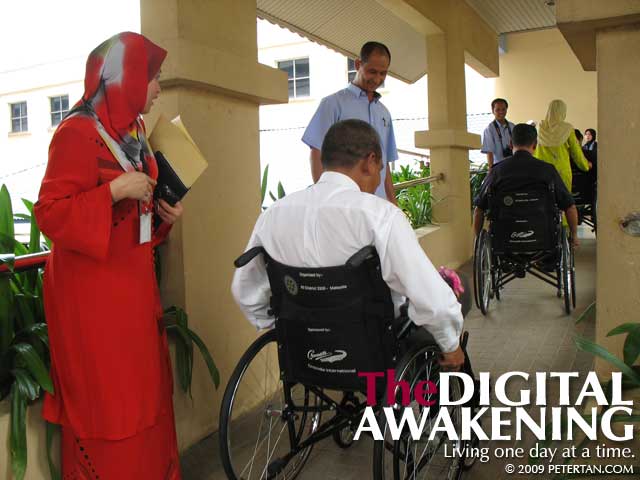
Participants going up a ramp on wheelchairs at MPAJ building.
The Majlis Perbandaran Ampang Jaya (MPAJ) took the first step today to make its administrative building compliant with MS 1184. The municipality organised Hari Kesedaran dan Simulasi OKU at Menara MPAJ in Pandan Indah. A simulation exercise was conducted by access audit facilitator Haslinda Hashim to show the top management of the municipality the problems faced by disabled people when they need to conduct business at the premises. Taking the lead in the exercise was its President Dato’ Mohammad Bin Yacob together with Council Members who went around on wheelchairs to use the ramps, toilet and counters.
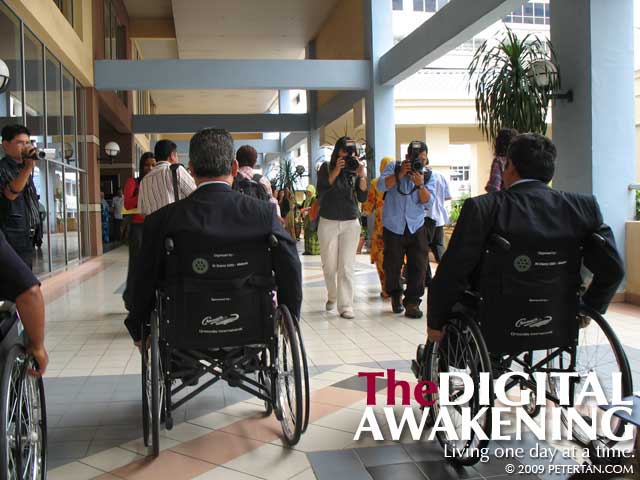
MPAJ President Dato’ Mohammad Bin Yacob (right) on wheelchair learning about issues faced by wheelchair users at the MPAJ building.
The first barrier they encountered was the rather steep ramp leading from the car park to the lobby. All of them had difficulty pushing themselves up. The President personally tested the toilet and also discovered that there was insufficient space to manoeuvre inside. At the payment counters section, the glass doors were difficult to open. Both door had to be opened to accommodate the entrance and exit of the wheelchairs. However, there was a low counter where disabled persons and senior citizens do not have to get a queue numbers to be served.
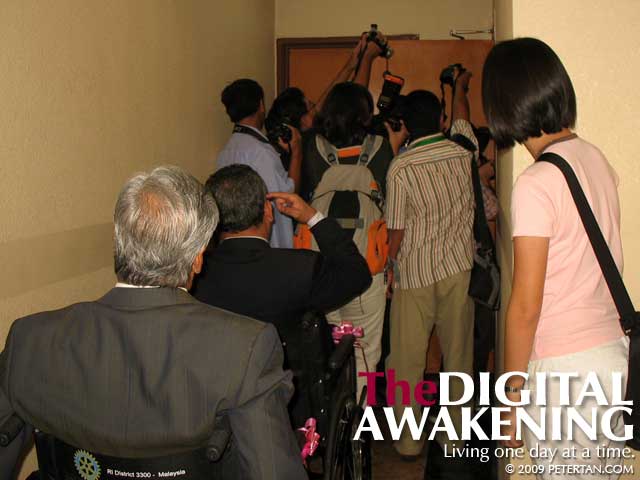
Reporters crowding around the toilet to photograph MPAJ President Dato’ Mohammad Bin Yacob testing out the accessible toilet.
Over lunch, I had the opportunity to have a few words with the President. I intimated to him that while the initiative by MPAJ to make the building accessible is a good move, there must be connectivity to the place. A fully accessible building is useless to disabled people if we are unable to get there due to the barriers in the street environment and public transport. The matter of accessibility must be viewed in totality instead of being done on a piecemeal basis.
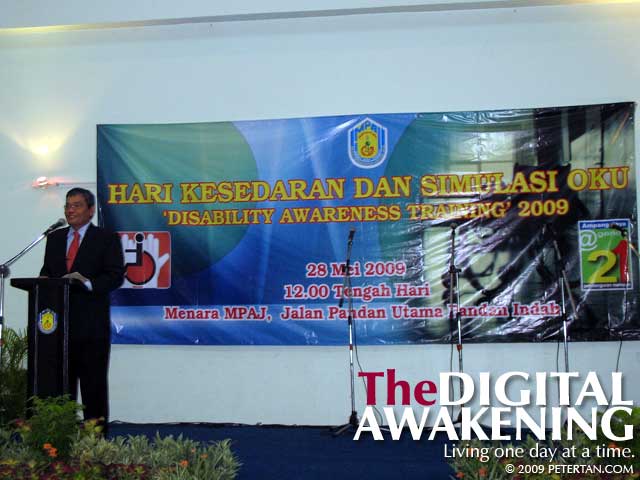
MPAJ President Dato’ Mohammad Bin Yacob giving a speech at the end of the training and instructed the relevant departments to rectify the problems regarding accessible facilities at MPAJ building.
Incidentally, the day’s event coincided with the MPAJ’s full council meeting, I also had the opportunity to discuss briefly regarding the same matters with Teratai ADUN Jenice Lee and Council Member Chan Su Sann. As I see it, there certainly is progress from the day a few friends and I met with Jenice after the general election in 2008 to present to her our case to her. Nevertheless, the going is extremely slow. I wonder if I will live to see the day when I can move around in the Klang Valley and Penang independently like what I experienced in Tokyo.


